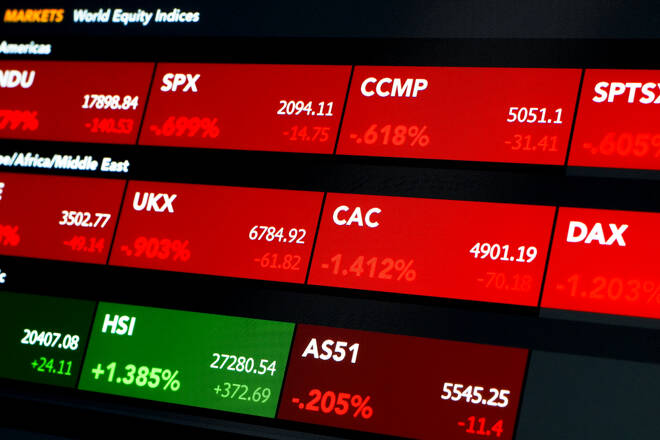Advertisement
Advertisement
European Equities: A Week in Review – 26/02/21
By:
It was a bearish week for the majors, weighed by reinflation fears. Economic data delivered a more optimistic outlook on the economy, however.
The Majors
After a run of mixed weeks for the European majors, it was a bearish final week in the week ending 26th February.
The EuroStoxx600 slid by 2.38%, with the CAC40 and the DAX30 ending the week down by 1.48% and by 1.22% respectively.
For the CAC40 and EuroStoxx600 the weekly loss ended a run of 2 consecutive weekly gains, while the DAX30 fell for a 3rd consecutive week.
While economic data continued to favor riskier assets, market jitters over reinflation and possible impact on monetary policy weighed on the majors.
Bond yields were on the rise in the week, with the 10-year U.S Treasury yields reaching a 1-year high.
The upside in the week came in spite of central banker attempts to placate market fears of a possible shift in monetary policy.
The Stats
It was also relatively busy week on the economic data front, with the French and German economies in focus.
From Germany, both business and consumer confidence improved in February and March respectively. Better than expected figures provided support ahead of a pullback later in the week.
German GDP numbers for the 4th quarter were also better than 1st estimate figures giving further support to the European majors.
At the end of the week, however, numbers from France disappointed. The French economy contracted by more than previously thought, with consumer spending sliding in January.
From the U.S
Consumer confidence was on the rise in February, supporting the market’s optimistic outlook on the economic recovery.
On Thursday, jobless claims and core durable goods orders were also positive.
Initial jobless claims fell back from 841k to 730k in the week ending 19th February.
There was also an upward revision to 4th quarter GDP figures. The U.S economy expanded by 4.1%, up from a 1st estimate 4.0%.
At the end of the week, inflation and personal spending figures also drew plenty of attention.
In January, personal spending jumped by 2.4%, more than reversing a 0.4% decline from December.
Inflationary pressures were also on the rise, albeit marginally. The FED’s preferred Core PCE Price Index ticked up from 1.4% to 1.5% at the start of the year.
On the monetary policy front, FED Chair Powell looked to calm market nerves over inflationary jitters over 2-days of testimony.
The Market Movers
From the DAX, it was a mixed week for the auto sector. Daimler fell by 1.19% to buck the trend in the week. Continental and Volkswagen rose by 2.02% and by 1.20% respectively, with BMW gaining 0.35%.
It was a bullish week for the banking sector, in spite of a Friday sell-off. Deutsche Bank rallied by 6.68%, with Commerzbank gaining 1.88%.
From the CAC, it was another particularly bullish week for the banks. Soc Gen rallied by 3.63%, with BNP Paribas and Credit Agricole gaining 1.97% and 2.56% respectively.
It was another mixed week for the French auto sector, however. Renault fell by 2.39%, while Stellantis NV ended the week up by 0.33%.
Air France-KLM surged by 12.98%, with Airbus rallying by 4.51%.
On the VIX Index
It was a 2nd consecutive week in the green for the VIX. In the week ending 26th February, the VIX jumped by 26.76%. Following a 10.42% rise from the previous week, the VIX ended the week at 27.95.
For the week, the NASDAQ slid by 4.92%, with the Dow and the S&P500 falling by 1.78% and by 2.45% respectively.
The Week Ahead
It’s a busy week ahead on the economic calendar.
Private sector PMI figures for Italy and Spain are due out along with finalized PMIs for France, Germany, and the Eurozone.
Barring material revisions to prelim figures, expect Italy and the Eurozone’s PMIs to have the greatest impact.
In the 1st half of the week, German retail sales and unemployment figures are also in focus.
A recent pickup in consumer sentiment suggests improving labor market conditions and a rise in spending. Expect any disappointing numbers to pressure the EUR.
Late in the week, Eurozone retail sales and unemployment figures and German factory orders are due out.
Germany’s factor orders will likely have the greatest impact. Manufacturing PMIs have pointed to a marked improvement in sector activity. Factory orders will need to be on the rise in January to be aligned with the survey-based figures.
From the U.S, the economic calendar is also on the busier side.
The market’s preferred ISM survey PMI numbers are due out along with ADP employment change figures in the first half.
We would expect the ISM non-manufacturing PMI to draw the greatest interest alongside the ADP numbers on Wednesday.
The focus will then shift to the weekly jobless claim figures on Thursday ahead of NFP and unemployment figures on Friday.
While the stats will provide the majors with direction, expect FOMC member chatter to also draw greater interest.
Concerns over a shift in monetary policy will leave the markets in search of more assurances.
A marked improvement in U.S labor market conditions could add more fuel to the reinflation fire that could test risk appetite.
About the Author
Bob Masonauthor
With over 28 years of experience in the financial industry, Bob has worked with various global rating agencies and multinational banks. Currently he is covering currencies, commodities, alternative asset classes and global equities, focusing mostly on European and Asian markets.
Advertisement
